Protein–Ligand Binding and Structural Modelling Studies of Pheromone-Binding Protein-like Sol g 2.1 from Solenopsis geminata Fire Ant Venom
Abstract
1. Introduction
2. Results
2.1. Piperidine Alkaloid Profiles from S. geminata Venom Extraction
2.2. Binding Assay
2.3. Fluorescence Binding Assay
2.4. Sol g 2.1 Protein Homology Modeling and Molecular Docking
2.5. Trail-Following Bioassay
3. Materials and Methods
3.1. Harvesting and Extraction of S. geminata Crude Venom
3.2. Binding Assay
3.3. Expression of Sol g 2.1 Protein in E. coli
3.4. Fluorescence Competitive Binding Assay
3.5. In Silico Studies, Homology Modeling, and Molecular Docking of Sol g 2.1 Protein and Ligands
3.6. Trail-Following Bioassay
3.7. Statistical Analysis
4. Discussion
Supplementary Materials
Author Contributions
Funding
Institutional Review Board Statement
Informed Consent Statement
Data Availability Statement
Acknowledgments
Conflicts of Interest
References
- Shi, Q.; Hu, L.; Wang, W.; Vander Meer, R.K.; Porter, S.D.; Chen, L. Workers and alate queens of Solenopsis geminata share qualitatively similar but quantitatively different venom alkaloid chemistry. Front. Ecol. Evol. 2015, 3, 76. [Google Scholar] [CrossRef]
- Chen, J.; Zhao, Y.; Li, X.; Zhao, J. Pyridine Alkaloids in the Venom of Imported Fire Ants. J. Agric. Food Chem. 2019, 67, 11388–11395. [Google Scholar] [CrossRef]
- Tschinkel, W.R. The Fire Ants; Harvard University Press: Cambridge, MA, USA, 2006. [Google Scholar]
- Hoffman, D.R. Fire ant venom allergy. Allergy 1995, 50, 535–544. [Google Scholar] [CrossRef]
- Blum, M.S. Ant venoms: Chemical and pharmacological properties. J. Toxicol. Toxin Rev. 1992, 11, 115–164. [Google Scholar] [CrossRef]
- Touchard, A.; Aili, S.R.; Fox, E.G.P.; Orivel, J.; Nicholson, G.M.; Dejean, A. The Biochemical Toxin Arsenal from Ant Venoms. Toxins 2016, 8, 30. [Google Scholar] [CrossRef] [PubMed]
- Carvalho, D.B.; Fox, E.G.P.; Santos, D.G.D.; Sousa, J.S.; Freire, D.M.G.; Nogueira, F.C.S.; Domont, G.B.; Castilho, L.V.A.; Machado, E.A. Fire Ant Venom Alkaloids Inhibit Biofilm Formation. Toxins 2019, 11, 420. [Google Scholar] [CrossRef]
- dos Santos Pinto, J.R.; Fox, E.G.; Saidemberg, D.M.; Santos, L.D.; da Silva Menegasso, A.R.; Costa-Manso, E.; Machado, E.A.; Bueno, O.C.; Palma, M.S. Proteomic view of the venom from the fire ant Solenopsis invicta Buren. J. Proteome Res. 2012, 11, 4643–4653. [Google Scholar] [CrossRef] [PubMed]
- Sukprasert, S.; Uawonggul, N.; Jamjanya, T.; Thammasirirak, S.; Daduang, J.; Daduang, S. Characterization of the allergen Sol gem 2 from the fire ant venom, Solenopsis geminata. J. Venom Anim. Toxins Incl. Trop. Dis. 2012, 18, 325–334. [Google Scholar] [CrossRef]
- Borer, A.S.; Wassmann, P.; Schmidt, M.; Hoffman, D.R.; Zhou, J.J.; Wright, C.; Schirmer, T.; Markovic-Housley, Z. Crystal structure of Sol i 2: A major allergen from fire ant venom. J. Mol. Biol. 2012, 415, 635–648. [Google Scholar] [CrossRef]
- Fan, J.; Francis, F.; Liu, Y.; Chen, J.L.; Cheng, D.F. An overview of odorant-binding protein functions in insect peripheral olfactory reception. Genet. Mol. Res. 2011, 10, 3056–3069. [Google Scholar] [CrossRef]
- Leal, W.S. Odorant reception in insects: Roles of receptors, binding proteins, and degrading enzymes. Annu. Rev. Entomol. 2013, 58, 373–391. [Google Scholar] [CrossRef]
- Vieira, F.G.; Rozas, J. Comparative genomics of the odorant-binding and chemosensory protein gene families across the arthropoda: Origin and evolutionary history of the chemosensory system. Genome Biol. Evol. 2011, 3, 476–490. [Google Scholar] [CrossRef]
- Honson, N.S.; Gong, Y.; Plettner, E. Structure and Function of Insect Odorant and Pheromone-Binding Proteins (OBPs and PBPs) and Chemosensory-Specific Proteins (CSPs). Recent Adv. Phytochem. 2005, 39, 227–268. [Google Scholar] [CrossRef]
- Terrado, M.; Pinnelli, G.R.; Plettner, E. Chapter 18: Mechanism and dynamics of insect odorant-binding proteins. In Insect Pheromone Biochemistry and Molecular Biology, 2nd ed.; Blomquist, G.J., Vogt, R.G., Eds.; Academic Press: Cambridge, MA, USA, 2021; pp. 591–618. [Google Scholar]
- Das, T.; Alabi, I.; Colley, M.; Yan, F.; Griffith, W.; Bach, S.; Weintraub, S.T.; Renthal, R. Major venom proteins of the fire ant Solenopsis invicta: Insights into possible pheromone-binding function from mass spectrometric analysis. Insect Mol. Biol. 2018, 27, 505–511. [Google Scholar] [CrossRef]
- Chen, L.; Lu, Y.Y.; Hu, Q.B.; Fadamiro, H.Y. Similarity in venom alkaloid chemistry of alate queens of imported fire ants: Implication for hybridization between Solenopsis richteri and S. invicta in the Southern United States. Chem. Biodivers. 2012, 9, 702–713. [Google Scholar] [CrossRef] [PubMed]
- Hussein, H.; Hameed, I.; Ubaid, J. Analysis of the Secondary Metabolite Products of Ammi majus and Evaluation Anti-Insect Activity. Int. J. Pharmacogn. Phytochem. 2016, 8, 1403–1411. [Google Scholar]
- Chen, L.; Hu, Q.B.; Fadamiro, H.Y. Reduction of venom alkaloids in Solenopsis richteri × Solenopsis invicta hybrid: An attempt to identify new alkaloidal components. J. Agric. Food Chem. 2010, 58, 11534–11542. [Google Scholar] [CrossRef]
- Hoffman, D.R.; Sakell, R.H.; Schmidt, M. Sol i 1, the phospholipase allergen of imported fire ant venom. J. Allergy Clin. Immunol. 2005, 115, 611–616. [Google Scholar] [CrossRef] [PubMed]
- Hoffman, D.R.; Dove, D.E.; Moffitt, J.E.; Stafford, C.T. Allergens in Hymenoptera venom. XXI. Cross-reactivity and multiple reactivity between fire ant venom and bee and wasp venoms. J. Allergy Clin. Immunol. 1988, 82, 828–834. [Google Scholar] [CrossRef] [PubMed]
- Srisong, H.; Sukprasert, S.; Klaynongsruang, S.; Daduang, J.; Daduang, S. Identification, expression and characterization of the recombinant Sol g 4.1 protein from the venom of the tropical fire ant Solenopsis geminata. J. Venom Anim. Toxins Incl. Trop. Dis. 2018, 24, 23. [Google Scholar] [CrossRef]
- Terrado, M.; Okon, M.; McIntosh, L.P.; Plettner, E. Ligand-and pH-Induced structural transition of Gypsy Moth Lymantria dispar pheromone-binding protein 1 (LdisPBP1). Biochemistry 2020, 59, 3411–3426. [Google Scholar] [CrossRef]
- Campanacci, V.; Krieger, J.; Bette, S.; Sturgis, J.N.; Lartigue, A.; Cambillau, C.; Breer, H.; Tegoni, M. Revisiting the specificity of Mamestra brassicae and Antheraea polyphemus pheromone-binding proteins with a fluorescence binding assay. J. Biol. Chem. 2001, 276, 20078–20084. [Google Scholar] [CrossRef] [PubMed]
- El-Sharif, H.F.; Stevenson, D.; Reddy, S.M. MIP-based protein profiling: A method for interspecies discrimination. Sens. Actuators B Chem. 2017, 241, 33–39. [Google Scholar] [CrossRef]
- Plettner, E.; Lazar, J.; Prestwich, E.G.; Prestwich, G.D. Discrimination of pheromone enantiomers by two pheromone binding proteins from the gypsy moth Lymantria dispar. Biochem. 2000, 39, 8953–8962. [Google Scholar] [CrossRef] [PubMed]
- Astiti, M.A.; Jittmittraphap, A.; Leaungwutiwong, P.; Chutiwitoonchai, N.; Pripdeevech, P.; Mahidol, C.; Ruchirawat, S.; Kittakoop, P. LC-QTOF-MS/MS Based Molecular Networking Approach for the Isolation of α-Glucosidase Inhibitors and Virucidal Agents from Coccinia grandis (L.) Voigt. Foods 2021, 10, 3041. [Google Scholar] [CrossRef]
- Nonkhwao, S.; Rungsa, P.; Buraphaka, H.; Klaynongsruang, S.; Daduang, J.; Kornthong, N.; Daduang, S. Characterization and Localization of Sol g 2.1 Protein from Solenopsis geminata Fire Ant Venom in the Central Nervous System of Injected Crickets (Acheta domestica). Int. J. Mol. Sci. 2023, 24, 14814. [Google Scholar] [CrossRef] [PubMed]
- Waterhouse, A.; Bertoni, M.; Bienert, S.; Studer, G.; Tauriello, G.; Gumienny, R.; Heer, F.T.; de Beer, T.A.P.; Rempfer, C.; Bordoli, L.; et al. SWISS-MODEL: Homology modelling of protein structures and complexes. Nucleic Acids Res. 2018, 46, W296–W303. [Google Scholar] [CrossRef] [PubMed]
- Edelsbrunner, H.; Mucke, E.P. Three-Dimensional Alpha Shapes. ACM Trans. Graph. 1994, 13, 43–72. [Google Scholar] [CrossRef]
- Labute, P. Protonate3D: Assignment of ionization states and hydrogen coordinates to macromolecular structures. Proteins 2009, 75, 187–205. [Google Scholar] [CrossRef]
- Attique, S.A.; Hassan, M.; Usman, M.; Atif, R.M.; Mahboob, S.; Al-Ghanim, K.A.; Bilal, M.; Nawaz, M.Z. A Molecular Docking Approach to Evaluate the Pharmacological Properties of Natural and Synthetic Treatment Candidates for Use against Hypertension. Int. J. Environ. Res. Public. Health 2019, 16, 923. [Google Scholar] [CrossRef]
- Chalissery, J.M.; Renyard, A.; Gries, R.; Hoefele, D.; Alamsetti, S.K.; Gries, G. Ants Sense, and Follow, Trail Pheromones of Ant Community Members. Insects 2019, 10, 383. [Google Scholar] [CrossRef]
- Billen, J.P.J. New structural aspects of the Dufour’s and venom glands in social insects. Naturwissenschaften 1987, 74, 340–341. [Google Scholar] [CrossRef]
- Campos, R.S.; Mendonça, A.L.; Cabral, C.R.J.; Vaníčková, L.; Do Nascimento, R.R. Chemical and behavioural studies of the trail-following pheromone in the leaf-cutting ant Atta opaciceps, Borgmeier (Hymenoptera: Formicidae). J. Insect. Physiol. 2016, 86, 25–31. [Google Scholar] [CrossRef] [PubMed]
- Brand, J.M.; Blum, M.S.; Fales, H.M.; MacConnell, J.G. Fire ant venoms: Comparative analyses of alkaloidal components. Toxicon 1972, 10, 259–271. [Google Scholar] [CrossRef]
- Barlin, M.R.; Blum, M.S.; Brand, M.M. Fire ant trail pheromones: Analysis of species specificity after gas chromatographic fractionation. J. Insect Physiol. 1976, 22, 839–844. [Google Scholar] [CrossRef]
- Igwe, O.U.; Offiong, S.P. Chemistry of Semiochemicals Used as Trail Pheromones in Tropical Fire Ant (Solenopsis geminata). Int. J. Boil. Chem. Sci. 2015, 7, 35–40. [Google Scholar]
- Choi, M.Y.; Vander Meer, R.K. Ant trail pheromone biosynthesis is triggered by a neuropeptide hormone. PLoS ONE. 2012, 7, e50400. [Google Scholar] [CrossRef]
- MacConnell, J.G.; Williams, R.N.; Brand, J.M.; Blum, M.S. New alkaloids in the venoms of fire ants. Ann. Entomol. Soc. Am. 1974, 67, 131–135. [Google Scholar] [CrossRef]
- Murali, R.V.N.S.; Chandrasekhar, S. Stereocontrolled synthesis of piperidine alkaloids, (−)-241D and (−)-isosolenopsin. Tetrahedron Lett. 2012, 53, 3467–3470. [Google Scholar] [CrossRef]
- Horst, R.; Damberger, F.; Luginbühl, P.; Güntert, P.; Peng, G.; Nikonova, L.; Leal, W.S.; Wüthrich, K. NMR structure reveals intramolecular regulation mechanism for pheromone binding and release. Proc. Natl. Acad. Sci. USA 2001, 98, 14374–14379. [Google Scholar] [CrossRef]
- Park, J.; Pham, H.V.; Mogensen, K.; Solling, T.I.; Bennetzen, M.V.; Houk, K.N. Hydrocarbon binding by proteins: Structures of protein binding sites for ≥C10 linear alkanes or long-chain alkyl and alkenyl groups. J. Org. Chem. 2015, 80, 997–1005. [Google Scholar] [CrossRef] [PubMed]
- Honson, N.S.; Johnson, M.A.; Oliver, J.E.; Prestwich, G.D.; Plettner, E. Structure-activity studies with pheromone-binding proteins of the gypsy moth, Lymantria dispar. Chem. Senses. 2003, 28, 479–489. [Google Scholar] [CrossRef] [PubMed]
- Laughlin, J.D.; Ha, T.S.; Jones, D.N.M.; Smith, D.P. Activation of pheromone-sensitive neurons is mediated by conformational activation of pheromone-binding protein. Cell 2008, 133, 1255–1265. [Google Scholar] [CrossRef] [PubMed]
- Vander Meer, R.K.; Williams, F.D.; Lofgren, C.S. Hydrocarbon components of the trail pheromone of the red imported fire ant, Solenopsis Invicta. Tetrahedron Lett. 1981, 22, 1651–1654. [Google Scholar] [CrossRef]
- Tillman, J.A.; Seybold, S.J.; Jurenka, R.A.; Blomquist, G.J. Insect pheromones-an overview of biosynthesis and endocrine regulation. Insect Biochem. Mol. Biol. 1999, 29, 481–514. [Google Scholar] [CrossRef]
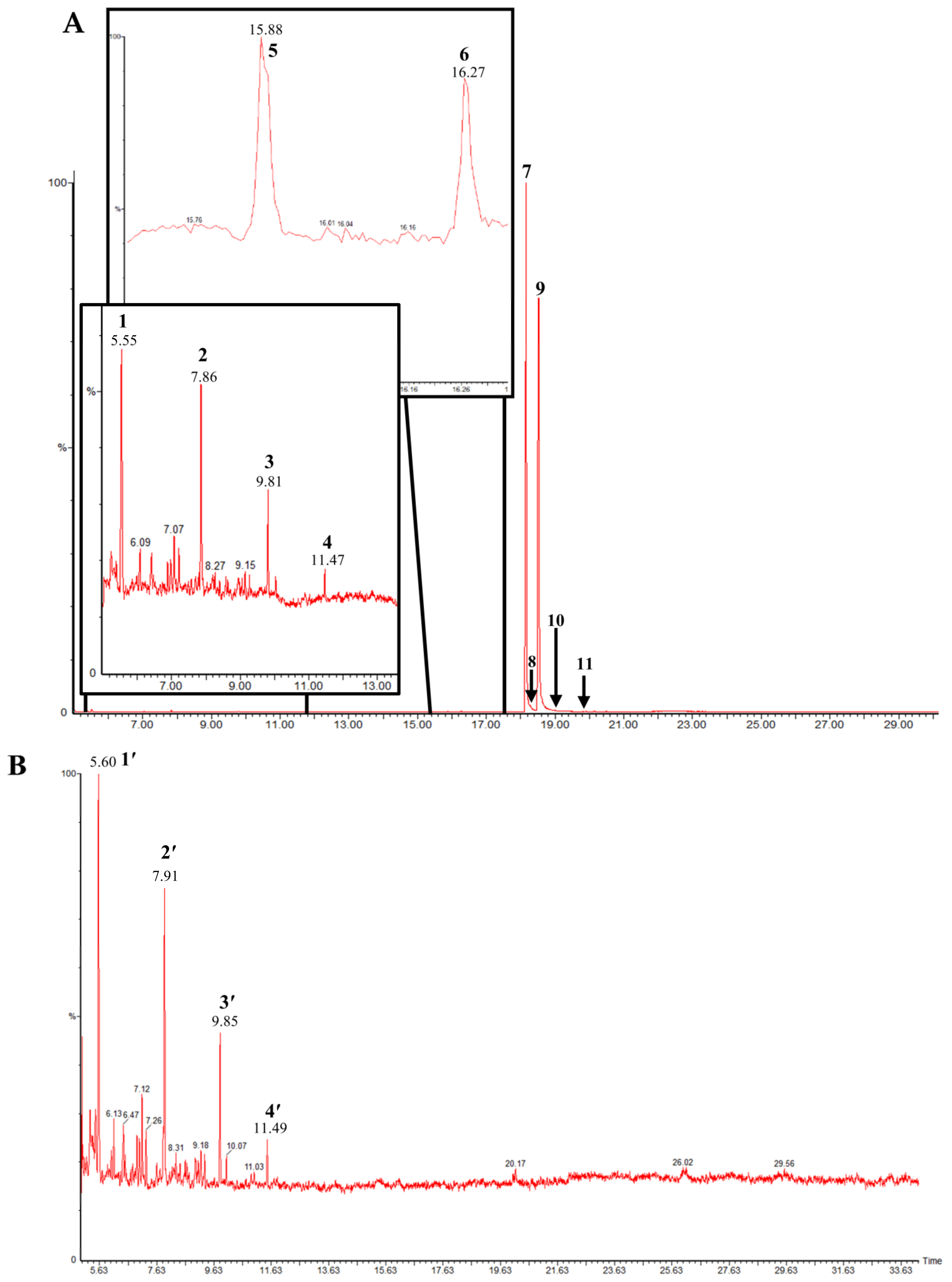
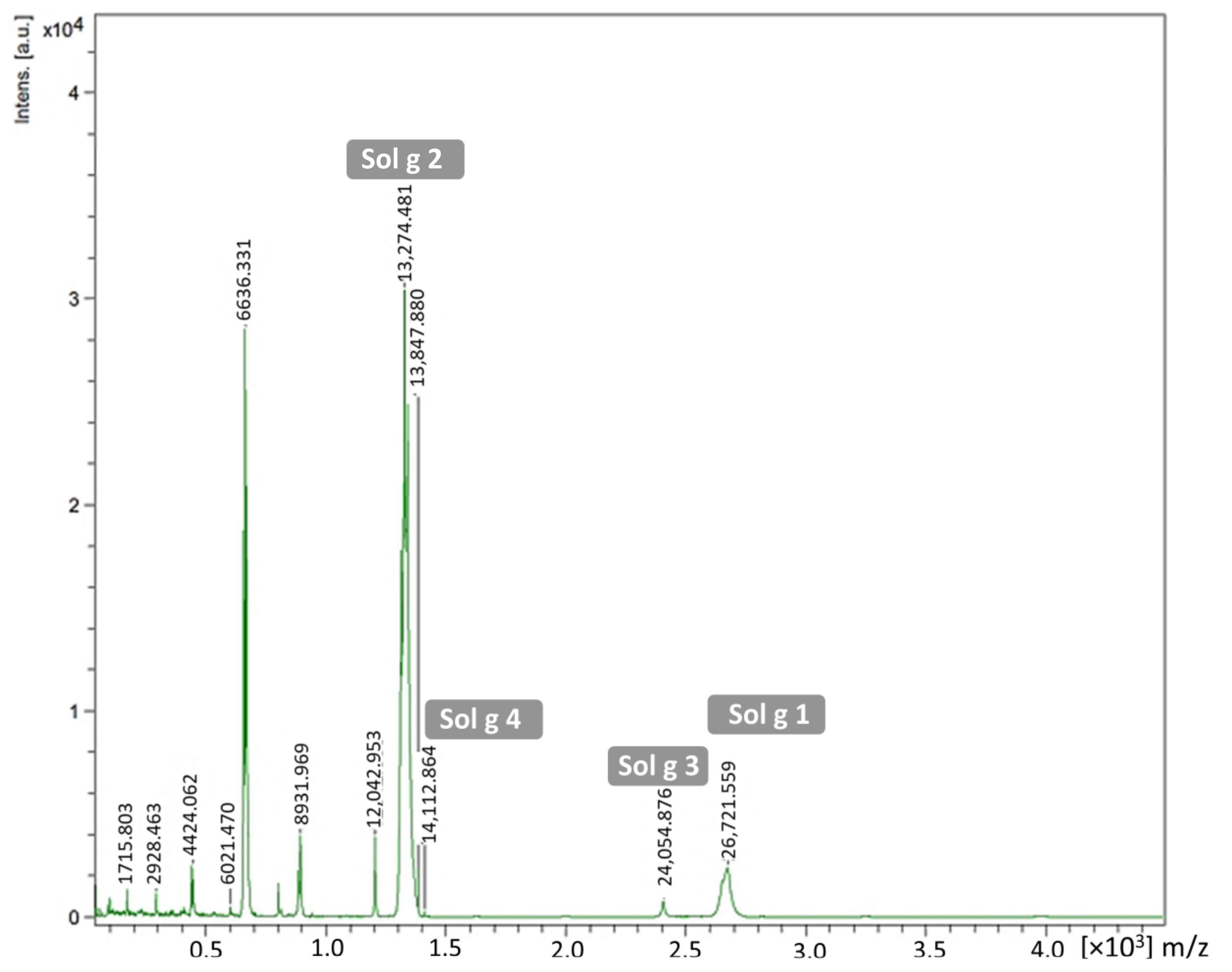
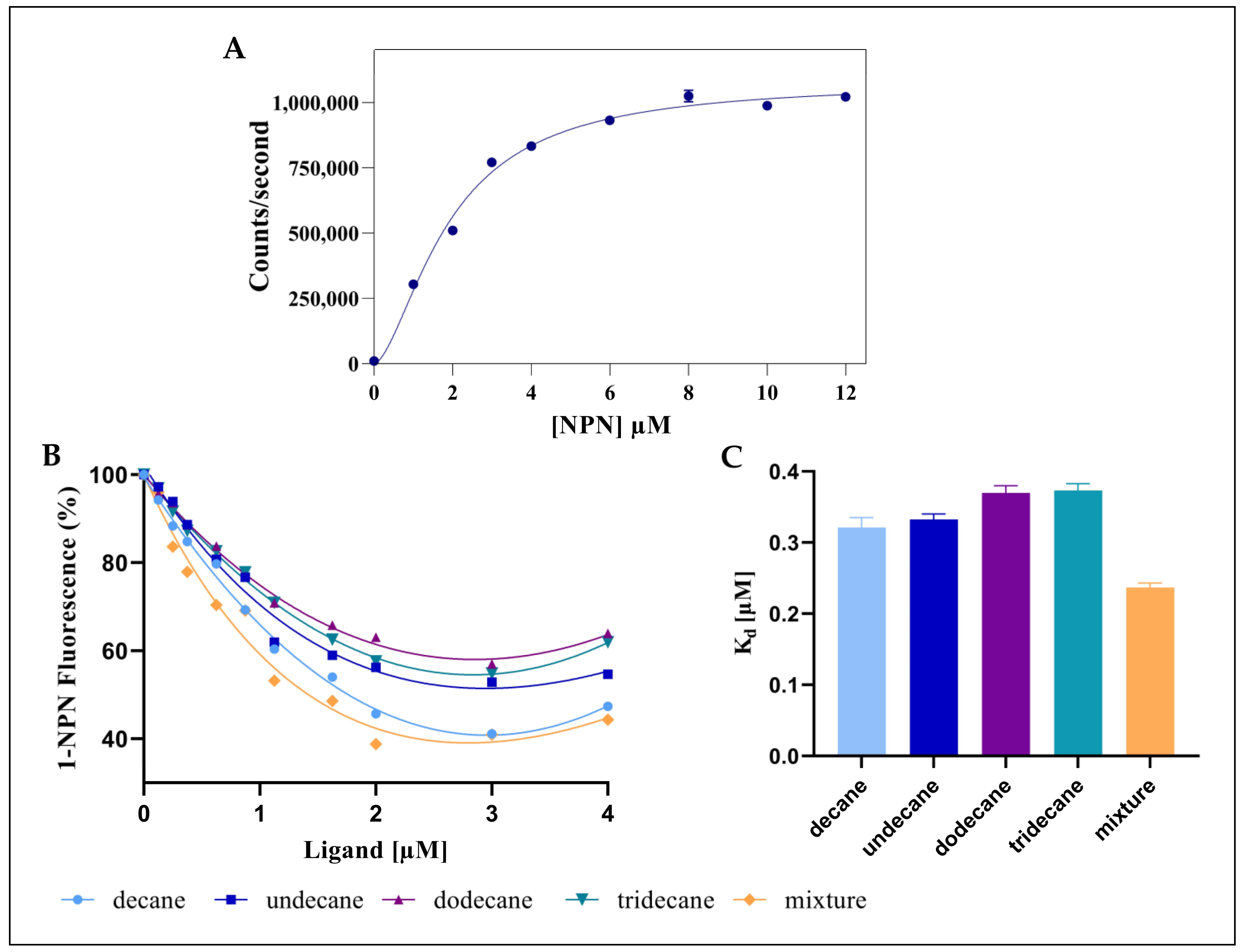
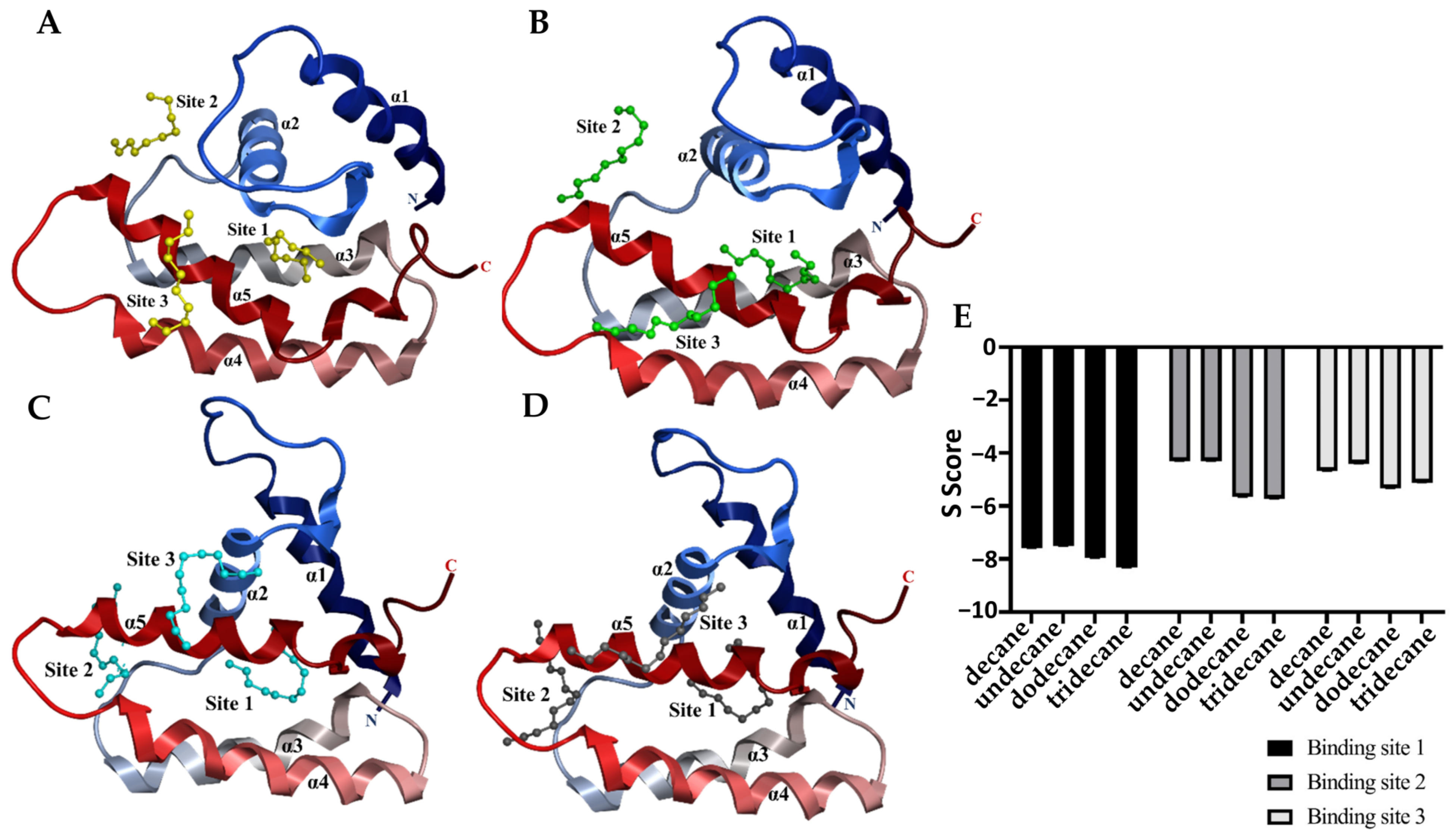
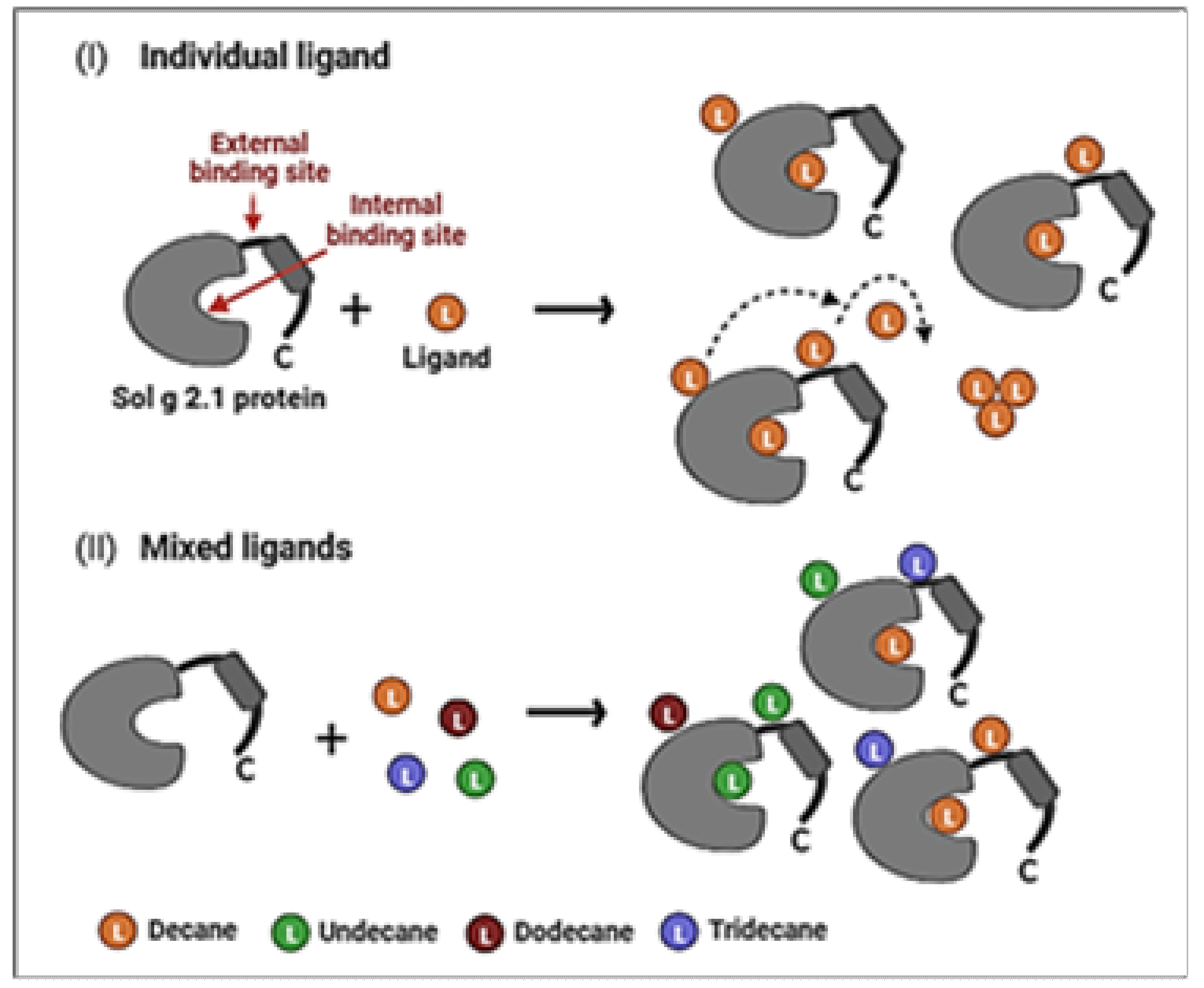
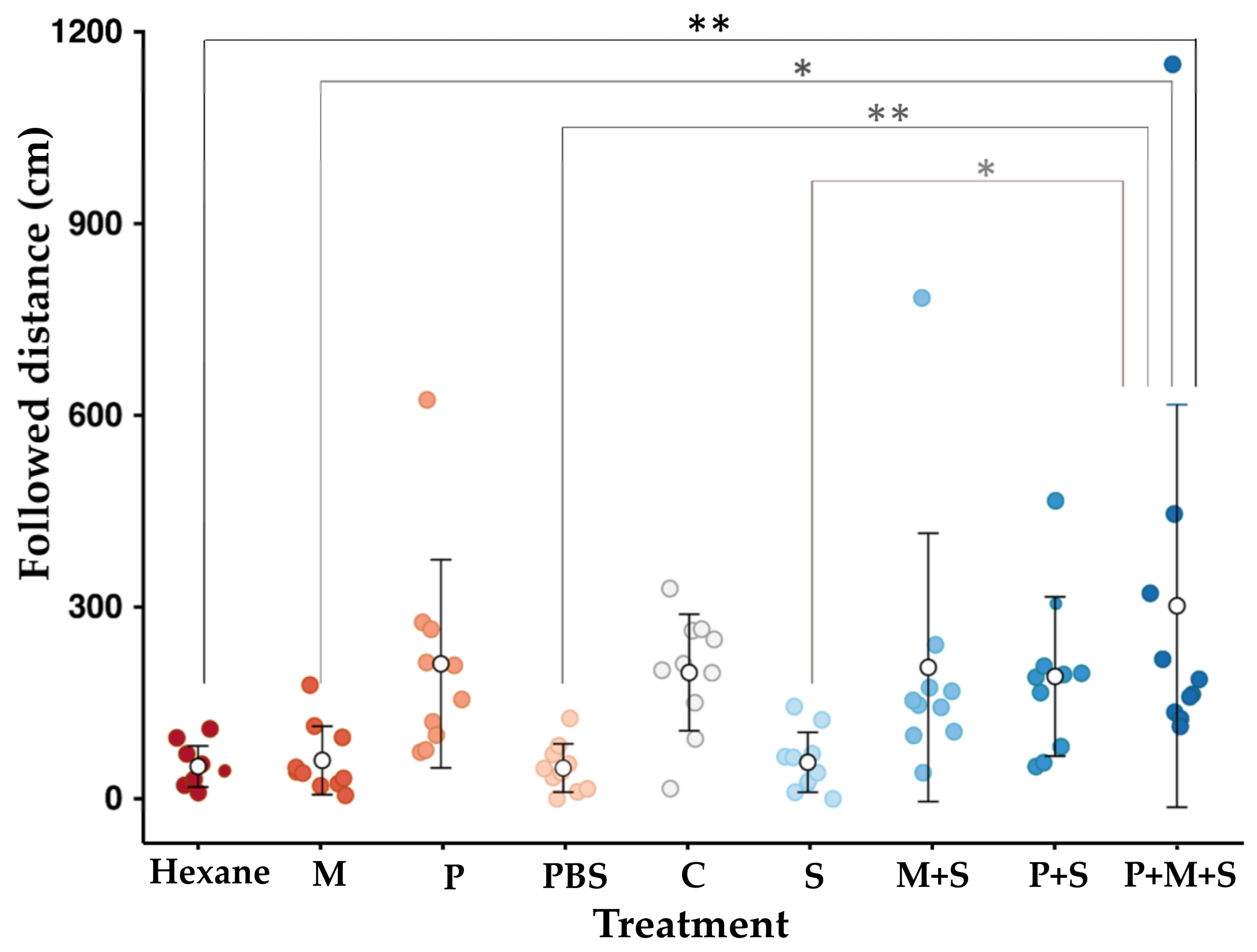
| Peak | Structure | Compound | RT (min) a | Mass b | Peak Area Ratio c (%) |
|---|---|---|---|---|---|
| 1 |  | Decane | 5.55 | 142 | 0.44 |
| 2 |  | Undecane | 7.86 | 156 | 0.21 |
| 3 |  | Dodecane | 9.81 | 170 | 0.12 |
| 4 |  | Tridecane | 11.47 | 184 | <0.1 |
| 5 |  | cis-2-methyl-6-nonylpiperidine | 15.88 | 225.41 | 0.11 |
| 6 | 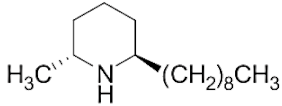 | trans-2-methyl-6-nonylpiperidine | 16.27 | 225.41 | <0.1 |
| 7 | 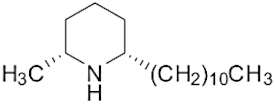 | cis-2-methyl-6-undecylpiperidine | 18.16 | 253.5 | 89.40 |
| 8 |  | 1,6-didehydro-2-methyl-6-undecylpiperidine | 18.29 | 252 | 0.44 |
| 9 | 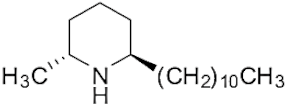 | trans-2-methyl-6-undecylpiperidine | 18.53 | 253.5 | 0.15 |
| 10 |  | cis-2-methyl-6-tridecylpiperidine | 19.03 | 281.5 | 9.20 |
| 11 | 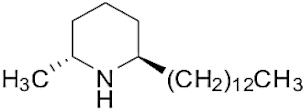 | trans-2-methyl-6-tridecylpiperidine | 19.89 | 281.5 | 0.10 |
| Band | Matched Protein | Accession | −10 lgP a | Average MW b | Peptide Sequence | Coverage (%) c | Species |
|---|---|---|---|---|---|---|---|
| C | Venom protein Sol g II | AAY32926.1 | 129.29 | 15,370 | KDIAECARTLPK CENQPDDPLAR RGVFDDPAPAAIKKK | 57 | S. geminata |
Disclaimer/Publisher’s Note: The statements, opinions and data contained in all publications are solely those of the individual author(s) and contributor(s) and not of MDPI and/or the editor(s). MDPI and/or the editor(s) disclaim responsibility for any injury to people or property resulting from any ideas, methods, instructions or products referred to in the content. |
© 2024 by the authors. Licensee MDPI, Basel, Switzerland. This article is an open access article distributed under the terms and conditions of the Creative Commons Attribution (CC BY) license (https://creativecommons.org/licenses/by/4.0/).
Share and Cite
Nonkhwao, S.; Plettner, E.; Daduang, S. Protein–Ligand Binding and Structural Modelling Studies of Pheromone-Binding Protein-like Sol g 2.1 from Solenopsis geminata Fire Ant Venom. Molecules 2024, 29, 1033. https://doi.org/10.3390/molecules29051033
Nonkhwao S, Plettner E, Daduang S. Protein–Ligand Binding and Structural Modelling Studies of Pheromone-Binding Protein-like Sol g 2.1 from Solenopsis geminata Fire Ant Venom. Molecules. 2024; 29(5):1033. https://doi.org/10.3390/molecules29051033
Chicago/Turabian StyleNonkhwao, Siriporn, Erika Plettner, and Sakda Daduang. 2024. "Protein–Ligand Binding and Structural Modelling Studies of Pheromone-Binding Protein-like Sol g 2.1 from Solenopsis geminata Fire Ant Venom" Molecules 29, no. 5: 1033. https://doi.org/10.3390/molecules29051033
APA StyleNonkhwao, S., Plettner, E., & Daduang, S. (2024). Protein–Ligand Binding and Structural Modelling Studies of Pheromone-Binding Protein-like Sol g 2.1 from Solenopsis geminata Fire Ant Venom. Molecules, 29(5), 1033. https://doi.org/10.3390/molecules29051033






